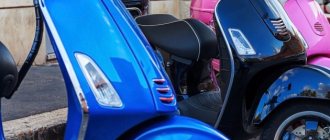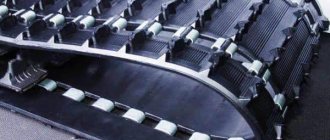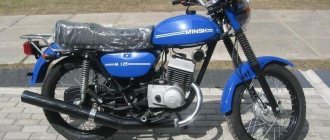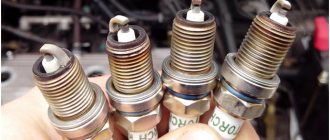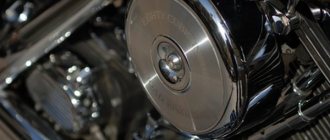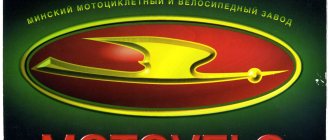MY MOTORCYCLE
Over the course of its existence, especially in recent decades, the Minsk Motorcycle Plant has passed through a breakthrough of carburetors: the Russian K-65S, the Czech Jikov 2924, the Indian Rasso P-47R and, in the end, created its own design of the engine power supply device - K-2401. Actually, the carburetor cannot be called a new product - its prototype was the “Hindu”. The Belarusian “youth” practically repeated the “parent” components and parts in appearance and filling. There is nothing to be surprised: it is no longer possible to introduce anything fundamentally new into a spool-type carburetor with mechanical throttle control from the throttle handle - the Belarusians have only modernized a number of elements.
The spool well cover K-2401 is secured with two screws. In the “precursor” it is screwed onto the carburetor body along a small thread of large diameter. It’s easier than ever to “sour” it (during the motorcycle’s winter “hibernation”) or to damage the threads of the “fine” thread with the hands of an inept mechanic. With K-2401 these troubles are excluded.
The channels connecting the float chamber with the atmosphere received foam filter inserts, thereby preventing the penetration of dust into it. This insidious substance is always abundant in the carburetor area, especially when driving on dirt roads. It was with this that the channels of the “ancestor” were often “choked.” The floats of the Belarusian carburetor are cast from foamed plastic. They are lighter than brass Rasso and more sensitive to fuel level control, and they have more lift. This means that the shut-off properties of the fuel valve are higher. In addition, the floats cannot become leaky or, when filled with gasoline, drown.
The K-2401 mechanism, which monitors the fuel level, can withstand lateral tilts of the motorcycle without consequences - the fuel level in the atomizer is not disturbed. Why? A pair of floats swing on a common axis that locks the needle valve. The needle is located under the entrance to the carburetor diffuser. Therefore, when driving uphill or accelerating, when fuel flows to the side against the direction of the motorcycle, the floats lower and open the needle. An additional portion of fuel enters the carburetor, the mixture becomes richer - and the engine power increases. On descents or when braking, the valve closes a little earlier than on the horizontal - the mixture becomes leaner and fuel is saved. We can say that the carburetor tracks the "tidal" waves of gasoline in the float chamber, using them for the benefit of the contents of the motorcyclist's wallet. The steel needle of the shut-off valve is equipped with an elastic damper washer. Thanks to it, the valve is sealed not only when driving on highways, but also when you drive off them to get to a place.
The starting device is used only when the engine is cold. The float sink has been removed from the structure - these are the demands of environmentalists. Indeed, there is no need to pour gasoline on nature in vain! But even without this “button” the carburetor ensures a stable start of the engine, cooled to minus 15°C. The device is turned on by pressing the lever “down,” which raises the valve for supplying the rich combustible mixture to the engine cylinder through a channel located near the throttle. Therefore, when starting, it is better not to touch the throttle. As soon as you turn it even a little, all the air will rush into the gap under the throttle, and not into the enrichment system, additional fuel will stop flowing, and the cold engine will not start.
The idle system prepares small portions of the combustible mixture for engine operation without load. In this mode, the carburetor throttle should be almost completely lowered, leaving a narrow “clearance” of about 0.8 mm in the diffuser - only then will the air rush along the path of “capturing” fuel from the idle system. Therefore, start adjusting the speed by setting the size of the “gap” - using the throttle stop screw (quantity screw), located on the side of the damper well. Using the second quality screw, located in the recess next to the inlet pipe, add air directly to the idle passages. Its adjustment is traditional: by tightening the screw, we enrich the mixture, and by moving it in the other direction, we lean it.
At the same time, the idle system smoothes the transition when the load on the engine increases (read: “giving it gas”), including the supply of the fuel mixture through an additional hole. They placed it in the “Indo-Belorus” successfully - the engine reaches full power without failures. Even under overloads, at which Jikov and K-65S make the motorcycle engine “sneeze”. And the supply of the mixture is stopped by a “transition” on time - at a quarter of the throttle opening.
The main metering system begins to operate when the throttle is raised more than 1/4 stroke. Part of the air enters through the inlet pipe into the hole with the air nozzle. A significant vacuum is created near the nozzle nozzle, which draws fuel through the main jet into the annular channel of the atomizer, and then into the diffuser. When the throttle position is from 1/4 to 3/4 stroke, the amount of fuel entering the engine is determined by the area of the “ring”: the cross-section of the nozzle minus the cross-section of the cone needle. In the last quarter of the throttle movement, the amount of fuel flowing out depends only on the throughput of the main fuel jet and, of course, the crankshaft speed.
The position of the needle relative to the throttle can be changed; for this purpose, grooves are machined on its body and there is a latch. But don't click it unnecessarily: every carburetor is carefully adjusted at the factory - don't knock it down. The diameters of the diffuser and mixing chamber of K-2401 are exactly the same as those of the “parent” - 24 mm. The standard Minsk cylinder doesn't need more.
K-2401 is installed on engines of the new family of MMVZ motorcycles with a center-to-center arrangement of mounting studs equal to 53 mm. When equipping older motorcycle models, up to the M-105, the new carburetor will require the intervention of a file. Bore its “ears” into an oval shape so that the studs, spaced 51 mm apart, fit into them. No other modifications are required.
K-2401 are produced in the city of Vileika, famous for its defense products. Night vision devices, optical sights, etc. are made here - this is precision production. Therefore, it is not surprising that the carburetor adopted not only the positive features of the “Hindu parent”, but also developed them. ……………………….
Engine tuning Minsk
An important principle of increasing motorcycle power is increasing cylinder volume . Since the motorcycle discussed in our article has a light, small-capacity engine, a couple of horses can be raised by boring the cylinder walls and replacing the piston with a larger size. At the same time, it will be useful to use new rings coated with chrome, as they minimize friction on the surface of the cylinder, thereby increasing engine life. The next step to increase power is to replace the fuel system. The standard carburetor has a primitive design and does not allow the engine to get maximum power, so you can replace it with a Keihin PWK flat-choke carburetor .
Compared to analogues, its flat throttle allows you to speed up the flow of the intake mixture by 30%, as well as an additional jet that comes into operation when the gas is fully opened, which, together with a good air filter, is an excellent do-it-yourself Minsk motorcycle tuning. In order not to disrupt the operation of the new carburetor, it will be useful to treat all intake channels from rough deposits and roughness that impede air flow.
It is worth paying attention to two main ways of tuning a Minsk motorcycle:
Firstly , the intake system can be significantly improved by installing a reed valve at the inlet of the cylinder after the carburetor. The reed valve will prevent the mixture from being pushed back into the fuel system when the piston makes its power stroke.
Secondly , replacing the standard muffler with a resonator made of sheet steel will not only allow you to lose weight, but also very significantly increase the power at medium and high engine speeds of the Minsk 125 motorcycle. Such tuning Minsk will not only improve power, acceleration and maximum speed, but and will make your faithful friend much more economical!
A good preventative measure for the engine would be to replace all its bearings with imported analogues. Due to the increased power of the motorcycle, the load on them will increase. Any Japanese bearing company has decent workmanship and a huge selection.
Another easy way to increase engine power is to increase the compression ratio . To do this, you need to trim the surface of the engine cylinder head by a couple of mm, this can be done on a lathe, or manually, using a piece of glass for this, placing it on a flat table, you get a perfectly smooth surface on which a sheet of sandpaper is glued to double-sided tape. Then the metal layer is ground off in a circular motion. After such tuning, the compression ratio in the cylinder will increase, which will also allow for fuel savings and increased power of the motorcycle. In this case, you will need to fill in 92nd gasoline.
Due to the increased power, it may be necessary to improve the clutch basket. To do this, remove the standard clutch discs, process them to a thinner state, removing 2 mm of metal from each disc, which will allow you to add several more of these clutch discs. Since their number will increase, which means the contact area will become larger, the efficiency of transmitting torque to the wheel will increase.
Tuning Minsk is not limited to the above. Installing a microprocessor-based non-contact ignition system (MPSZ) will improve the response of the Minsk motorcycle engine to the throttle, eliminate problems with starting the engine in cool weather, and also allow for smooth engine operation throughout the entire range, due to the fact that the spark occurs in proportion to the increase in the number of revolutions crankshaft The higher the speed, the earlier the spark occurs. Cam ignition will never achieve such results; it is not reliable and often goes astray.
Flaws
First, let's figure out what shortcomings the motorcycle has, this will allow us to decide what needs to be improved first. In general, many problems are typical for domestic motorcycles, and when tuning sunrise 3m they are faced with the same problems.
The main disadvantages of the motorcycle are as follows:
- Low-power engine. The most powerful engine is only 13 hp;
- On the earliest models, the placement of the crankshaft bearings was unsuccessful;
- Poorly designed clutch;
- Weak brakes.
These are the main disadvantages of Minsk. In general, it is worth noting that all of the above can be eliminated with your own hands, significantly improving the performance of the motorcycle.
Video Review
Specifications
| Maximum engine power: | 9 HP |
| Working volume: | 125 cm3 |
| Motor type (cylinder arrangement, number of strokes): | |
| Number of valves: | |
| Intake type (Injector / Carburetor): | |
| Bore and stroke: | |
| Starting system (Electric starter, kick starter): | |
| Maximum speed in km/h: | 95 km/h |
| Cooling system: | Air cooling |
| Transmission (gearbox): | 4-speed, manual |
| Clutch (Dry / Wet): | |
| Drive unit: | Chain |
| Frame: | Steel |
| Chassis | |
| Suspension (front/rear travel): | |
| Brakes (Front/Rear): | |
| Wheels / Tires / Rubber: | |
| Dimensions and weight | |
| Dimensions (Length / Width): | |
| Seat height: | |
| Ground clearance: | |
| Curb weight: | |
| Wheelbase: | 1230 mm |
| Weight: | 113 kg |
| Fuel tank capacity: | 11 l. |
| Battery capacity: | |
| Year of release: | |
| Country of Origin: |
Advantages and disadvantages
Advantages
- Unpretentiousness . The motorcycle is capable of running on any gasoline, and, most likely, it will even run on AI-76 without any problems, if you suddenly manage to get it somewhere.
- Economical . Spare parts can be found in any village, and they are cheap. And gasoline consumption does not exceed 3-4 liters per hundred kilometers, which is quite good for an ancient two-stroke engine.
- Maintainability . You can repair Minsk 125 Leader on your own, even in a garage, even in an open field, if only you had the tools at hand.
Flaws
- Low reliability . When buying this bike, it is better to prepare in advance for possible breakdowns that you will have to fix yourself. But this is caused more by the age of all surviving specimens than by design flaws.
- Small resource . A two-stroke engine, even with normal maintenance, is inferior in this parameter to a four-stroke engine.
- It is necessary to add oil to the gas tank when refueling . And this, you see, is not very convenient.
Technical characteristics of Minsk Leader 125
Taking the MMVZ-3.1131 model as a basis, Belarusian designers changed practically nothing about it. They added plastic cladding to the sidewalls, lifted the muffler up, and for some reason tilted the rear shock absorbers... Considering that the motorcycle went on sale in 1999, all these cosmetic changes were like a poultice for a dead man. It is hopelessly outdated, and in general it is surprising that it lasted on the assembly line for five whole years. However, for people who are nostalgic for Soviet motorcycles, the Minsk 125 Leader can be recommended for purchase even now - with proper care it is quite reliable, it’s just not so easy to find a “live” copy.
In terms of design, it represents the cutting edge of 40 years of design. A conventional frame made of ferrous metal , a 2-stroke air-cooled engine (9 hp) , capable of accelerating a motorcycle to 90 km/h (according to the passport, in reality the bike is quite capable of reaching speeds of up to 110 km/h), carburetor, chain, drum brakes. A typical representative of the Soviet era, who for some reason did not go into the past along with it, but continued to live with completely incomprehensible goals.
Yes, we must admit that Minsk 125 Leader has its own advantages even without discounting its age and archaism. It is very simple, any beginner can understand its design, and repairs do not require any special skills. As a training bike, it has a right to life even now, especially taking into account the fact that a motorcycle in “running” condition can be bought for thousands of people for five rubles. It weighs only 113 kg and is surprisingly easy to control, so it is perfect for training novice motorcyclists, contributing to the development of not only driving skills, but also repair.




